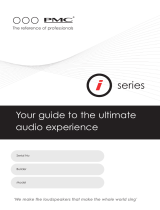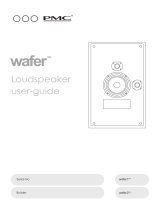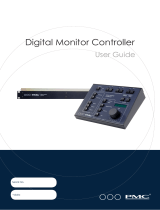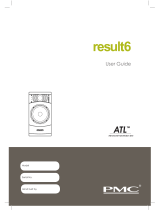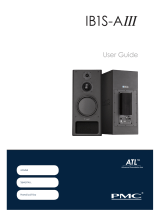Page is loading ...

fact
®
Key to the
Model
No.
Hand built by
Date


is a groundbreaking range of loudspeakers that provides just that.
The unadulterated essence of the recording delivered by a wholly elegant form.
fact
®
fact - noun - a thing known to be true with complete certainty.The denition of

Warranty Certicate
Please take a few moments to complete the warranty card at the
back of this booklet or register at www.pmc-speakers.com. This records
the purchase of your loudspeakers and provides you, the customer an
opportunity to make suggestions and provide feedback directly to PMC.
Product Support
For product support, accessories or servicing advice, please contact
a PMC authorised dealer - See www.pmc-speakers.com.
THE PROFESSIONAL MONITOR COMPANY LIMITED
HOLME COURT BIGGLESWADE SG18 9ST UK
T +44 (0)1767 686300 F +44 (0)870 4441045
E [email protected] www.pmc-speakers.com
IMPORTANT - Complete your warranty
© 2018 PMC. All rights reserved.
Version v2 - #421
PMC Stock Code: 14562

A message from Peter Thomas –
Peter Thomas
Owner & Chief Designer
“
Our sole aim while designing loudspeakers is to recreate the true essence of
an artist’s intention, combining the ultimate level of sonic resolution with solid
engineering principles.
We believe that the same loudspeaker can be used throughout the entire audio
chain, from composer to studio or lm stage, post-production or mastering and then,
nally, the consumer. Our unswerving passion for getting it right has made this goal
possible.
Thank you for choosing PMC products. It is now time for you to read the user guide,
install your new speakers, and realise just how much you’ve been missing.

Congratulations - You have joined the elite.
For over twenty-ve years PMC has
earned an unrivalled reputation for
creating the world’s nest professional
loudspeakers. Simply put, our speakers
provide a reference for the world’s
highest prole productions and events.
They are found at every stage of the
creative process, from conception
to recording and broadcast and, of
course, in the home.
Our client list reads like a who’s who
of the sonically aware, with John
Newman, Elbow, Stevie Wonder,
Coldplay, Brian May, Universal, EMI,
Sony, Pinewood Studios, Dreamworks,
Deutsche Grammophon and the BBC
among the makers of movies and
music who use our products.
Our loudspeakers were also used in
the production of Titanic, Spiderman III,
James Bond’s Skyfall and Spectre,
Finding Nemo, Pirates of the
Caribbean III, and during broadcasts
of the Beijing and London Olympics.

Wisseloord Studios - one of the world’s leading music production facilities, PMC equipped
The combination of accumulated technical
knowledge and the experience gained from being
close to the creators of music has been distilled
into the fact range - you will hear it exactly as the
artist intended with all the passion and emotion of
the performance.

Contents
Tip
Tip
General usage guidelines
Tip
Tip
PMC’s
TM
Advanced Transmission Line
- Basically speaking
Tip
Tip
TM
Advanced Transmission Line
- Technically speaking
Tip
Tip
Our meticulous attention to detail
Tip
Tip
Unpacking
Tip
Tip
Spike Installation guide
Tip
Tip
Connections
Tip
Tip
Connecting to an amplier fact.3 & fact.8
Tip
Tip
Connecting to an amplier fact.12
Tip
Tip
Running in or breaking in
Positioning
Tip
Tip
Stereo set-up
Tip
Tip
Surround sound specic set up
Tip
Tip
Ideal 5.1 surround sound set up
Tip
Tip
Ideal 7.1 surround sound set up
Tip
Tip
Fine tuning for perfect sound
Tip
Tip
Service
Tip
Tip
Specications
Tip
Tip
Warranty on-line
Tip
Tip
Warranty certicate - Part 1 - Your copy
Tip
Tip
Warranty certicate - Part 2 - Our copy
Tip
Tip
Help us improve - Your Comments
Tip
Tip
Inspection certicate
fact
®user guide
Tip
Tip

Tip
Tip
Read these instructions and keep them in a safe place for future reference.
Tip
Tip
Heed all electrical safety warnings, including any on the loudspeakers themselves.
Tip
Tip
Do not use the loudspeakers near water.
Tip
Tip
We have provided a high quality Microber cloth for cleaning. This is ideal as the cabinet
should only be cleaned with a dry, lint-free, cloth. Do not use solvents, abrasives, waxes
or liquids as they may be detrimental to the nish.
Tip
Tip
Floor spikes are sharp and should be treated with great care during installation and use.
Tip
Tip
Do not install near any heat sources such as radiators, ovens or other equipment that
produce excessive heat.
Tip
Tip
Unplug this product from both source and power during electrical storms or when unused
for extended periods of time.
Tip
Tip
Packing material can pose danger to the young and vulnerable.
Ensure these items are kept or disposed of safely.
Tip
Tip
High volume audio signals, however short their duration, have the potential to cause
hearing damage. Use care when setting the system volume level to ensure playback
sound pressure levels remain within safe comfortable limits.
Tip
Tip
Do not attempt to service the equipment. There are no user serviceable parts inside.
Please refer all servicing to PMC authorised personnel.
Tip
Tip
Servicing is required when the apparatus is damaged, exposed to moisture,
or exhibits a distinct or sudden change of operation or audio performance.
Tip
Tip
PMC has made efforts to provide accurate installation information and good quality
xings. The Professional Monitor Company Limited (PMC) will not be held responsible or
liable for injuries or property damage - direct, indirect or consequential - arising out of use
or inability to use this product safely and properly.
Tip
Tip
fact loudspeakers contain powerful magnets and may have a detrimental effect if left in
close proximity to magnetically sensitive items, e.g.; CRT televisions or monitors and media
such as oppy discs, audio and videotapes.
General usage guidelines
Tip
Tip

Basically speaking
fact.12 cross section showing
ATL ™ bass loading
Tip
Tip
The world’s leading professionals rely on the
accuracy of PMC’s designs everyday to
create much of the music and sound you
hear. You can rest assured that what you hear
from a PMC speaker is identical to the version
approved by the artist themselves.
What they offer above a standard HiFi speaker
Detail - They are extremely detailed and
sound natural - As if the musicians are with you
in the room
Room lling - The sound they produce covers a
massive area, so wherever you sit you still hear
everything
Full, rich sound at any volume - You can listen at
low level and still hear bass - Ideal for low level
or late night listening
Reliability - Our technology is tried and tested in
the professional world
Ease of drive - They are efcient and therefore
can be driven by the vast majority of good
quality ampliers
TM
Advanced Transmission Line

Tip
Tip
the upper bass and midrange detail
is not masked by harmonic distortion
residing in the very low frequencies.
The result is PMC’s characteristic
transparent midrange and fast,
attacking bass notes, all reproduced
with outstanding clarity.
A further advantage of the transmission
line approach is a cabinet that
produces a higher volume and
greater bass extension than a ported
or sealed design of a similar size,
even if identical drivers were used.
Moreover, as the loading on the main
driver is maintained at all volumes,
the frequency response also remains
consistent regardless of listening level.
Casual late night listening or analytical
studio sessions can be conducted
without the need for high volumes to
achieve maximum bass response. A
characteristic that is especially suited
to both the home enthusiast and
recording professional alike.
‘No other technology provides such a huge, rich room lling sound’
Technically speaking
PMC’s ATL™ (Advanced Transmission
Line) enclosures have taken loudspeaker
design to the highest level.
A PMC transmission line design utilises
sophisticated cabinet construction,
propriety drive units and patented
absorption materials and techniques.
The benets are enormous compared to
the relatively simple sealed and ported
models currently available elsewhere.
The bass driver is placed at one end
of a long tunnel (the transmission line),
which is heavily damped with absorbent
acoustic material. This material is
specied to absorb the upper bass and
higher frequencies that radiate from the
rear of the bass driver.
The lowest frequencies, which remain
in phase, then emerge from the large
vent at the end of the line, which
essentially acts as an additional driver.
One advantage to this approach is that
the air pressure loading the main driver
is maintained, thus controlling the driver
over a wide frequency range, which in
turn signicantly reduces distortion. A
spin-off from the lack of distortion is that

All PMC loudspeakers are hand-built in the U.K. using individual
components that are matched to our reference model; this includes
the structural integrity of every cabinet and the testing and recording of
each component. This guarantees it will be within our strict tolerances
and ensures your purchase sounds identical to the original design.
Each completed loudspeaker then undergoes a set of objective and
subjective measurements - frequency response sweeps ensure that the
design meets our exacting performance criteria, and then listening tests
are conducted against the reference model using a wide variety of
material, from a benchmark BBC speech test to classical music,
pop and rock.
Tip
Tip
Our meticulous care & attention

Tip
Tip
Unpacking
Please retain your packaging for future use as all PMC cartons
are durable, reusable and can be employed to safely transport
your loudspeakers should they be relocated or returned
for servicing.
Much of the packing is constructed from recyclable materials,
so if you are to dispose of it please do so in an environmentally
friendly manner.
Packing materials can pose danger to
animals, the young and vulnerable.
Ensure these items are kept or
disposed of safely.
!

Spike installation guide
(for fact.3 stands, see individual installation guide)
Tip
Tip
Spikes are used to enhance performance and allow the loudspeaker to be
levelled perfectly. fact spikes are reversible, with spike or ball tips for use on
either carpeted or more sensitive hard ooring.
Note: If you require additional protection when using the ball ended tips on
hard ooring then use the handy protection caps included.
Tip
Tip
Carefully invert the loudspeaker so that its base is uppermost. Take
care not to damage the top of the loudspeaker when it is upside-
down, the use of a soft cloth or square of carpet is suggested.
Tip
Tip
Thread each spike with one of the supplied knurled collars/nuts.
Tip
Tip
Select the type of tip you wish to use. Generally spikes are used for
carpeted oors and ball ends for hard oors
Tip
Tip
The spikes can then be inserted into the threaded hole.
Caution: Spikes are sharp and should be treated with great
care and may damage hard ooring if in direct contact.
Tip
Tip
Re-invert the loudspeaker
Tip
Tip
Once in position, level the loudspeaker by adjusting each
spike in turn using the spirit level on the top of the cabinet to
conrm. While this might seem a time-consuming exercise,
it is important both in terms of system performance and the
stability of the loudspeaker.
Tip
Tip
The nal step is to tighten each knurled collar/nut; this will ensure that
the spike and loudspeaker are as rigid as possible.
!

Connections
Tip
Tip
Plugging them in
Caution
To avoid potential damage, please ensure that your power amplier(s) or
receiver is turned off before connecting or disconnecting your loudspeakers.
Cable & connectors
When selecting cables for use with your fact loudspeakers, ensure that
their construction is of a high enough standard to withstand the rigors of
everyday use and that they are suitably terminated. While bare wire can be
accommodated by the fact Ag binding posts, we recommend the use of either
spade lugs or 4mm ‘banana’ plugs in order to maintain an electrical connection
of the highest integrity and avoid the possibility of short circuits. Please consult
your dealer for more information regarding cable lengths and termination
options.
Polarity + & -
It is of vital importance to observe the polarity markings and maintain
positive-to-positive and negative-to-negative connections from amplier
or receiver to the loudspeaker. The fact Ag terminals are colour-coded to aid
in their identication, positive terminals are red, negative terminals are black.
!

Connecting to an amplier
Tip
Tip
HF
LF
+
-
+
+
-
-
+
+
-
-
HF
LF
Standard/single wiring Bi-wiring Bi-amp wiring
Standard / Single wiring connection
This is the most common using a single cable with two conductors. Connect
using any of the two pairs of RED+/BLACK- terminals. Ensuring the fact Ag
silver linking bars are secure and the binding posts are nger tight.
Advanced connection / Bi-wiring & Bi-amping
fact models with four binding posts can be bi-wired or bi-amped.
By loosening all four rear binding posts, the silver bridging plates can be
removed thus enabling separate signals to be fed to the low (Woofer)
and high frequency (Tweeter) drivers. Ensure the binding posts are re-
tightened after the bridging bars are removed. Both bi-wiring and bi-amping
require the use of two lengths of cable per speaker. Bi-amping requires
two separate ampliers; one for each driver. Please consult your dealer
regarding the benets and the correct procedure.
Terminal identication
Top pair of terminals - HF / High Frequency / Tweeter
Bottom pair of terminals – LF / Bass Frequency / Woofer
Back panel diagrams

Connecting to an amplier
Tip
Tip
Standard/single wiring Bi-wiring Tri-wiring
Bi-amp wiring Tri-amp wiring
HF
LF
MF
HF
LF
+
-
MF
HF
LF
MF
HF
LF
MF +
+
-
-
+
-
HF
LF
MF
+
+
-
-
Standard / Single wiring connection
Connect using any of the three pairs of RED+/BLACK- terminals. Ensure the
linking bars are secure and the binding posts are nger tight.
Advanced connection
The fact.12 can also be bi-wired, bi-amped, tri-wired or tri-amplied. By
loosening all six rear binding posts, the linking bars can be removed so
separate signals can be fed to the LF (Woofer), MF (50mm Dome) and HF
(Tweeter) drivers. Ensure the binding posts are re-tightened after the linking
bars are removed.
Both bi-wiring and bi-amping use two lengths of cable per speaker, tri-wiring
and tri-amping use three lengths per speaker. Bi-amping also uses two
separate ampliers; tri-amping uses three, one for each driver.
Terminal identication
Top pair of terminals - HF / High Frequency / Tweeter
Middle pair of terminals - MF / Mid Frequency / 50mm Dome
Bottom pair of terminals - LF / Bass Frequency / Woofer
Back panel diagrams

Running in or breaking in
Tip
Tip
12
11
10
9
8
765
4
3
2
1
When loudspeakers are new they will take time to reach their full potential.
It is often debated whether any solid-state equipment, such as CD players or
transistor-based power ampliers change with use, but the characteristics of
mechanical devices such as loudspeakers do alter and improve their perfor-
mance signicantly after a short ‘running in’ period.
The science is simple; as the soft material surrounding the dome or woofer
cone is exed it will eventually reach a point where it has optimum compli-
ancy allowing the drive unit to move more freely. This translates to greater
accuracy and speed of attack in the bass region and the mid and high fre-
quency produces a far more vivid audio picture. This short ‘running in’ period
takes approximately 15 hours of normal use.

With their unique ATL™ Advanced Transmission Line design, wide dispersion, ultra
low distortion and smooth bass roll-off, PMC loudspeakers are more forgiving of
difcult room conditions and placement constraints than conventional designs -
you will be able to achieve a superb sound throughout the room with little effort.
We do encourage you to spend some time experimenting in your own room
in order to achieve the very best results. Remembering that small changes in
location can often inuence system performance.
Room shape, size, construction and interior decoration vary immensely and
therefore inuence sound in different ways. The following guidelines are
suggestions for the starting point to locate your new speakers. Fine-tuning of
their positioning can start from here.
Tip
Tip
Positioning

• Place the speaker so the front face is slightly forward of any large object
that protrudes into the room - this could be a replace, bookcase
or television for example.
See stereo set up diagram
• Ensure that stereo pairs of loudspeakers are equidistant from the listening
position.
• It is best to position the front left/right pair (and centre channel loudspeaker
if you have a surround system) at the same height, usually at ear-level when
seated at the listening position.
If any of the speakers are mounted above or below ear level, then angle the
speaker towards the listening position.
• The distance between your left/right speakers and the listening position
should ideally create an equilateral triangle. As a general rule, the width
of the audio picture will be narrow if the speakers are too close together. If
they are too far apart the picture will be wide but there will be less central
denition
Use a well recorded vocal track to judge the ideal spot.
• To further enhance the audio picture or soundstage the speakers can
be angled/toed-in’. Start with the speakers angled so they will cross
approximately 50cm (2ft) behind the listening position. (See stereo set-up
diagram) Varying this angle will also subtly affect the vividness of the audio
picture, so again experiment.
A simple well recorded band with vivid vocals will help to achieve the best
position
Tip
Tip
Positioning (Cont.)
Tip
Tip
Tip
Tip
/



